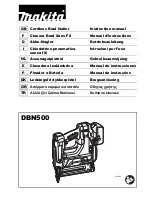
2- ENG LISH
FOR YOUR MODELS.
Do not use the wrong fasteners or
load the fasteners incorrectly.
•
CHECK FOR MISALIGNMENT OR BINDING OF
MOVING PARTS, BREAKAGE OF PARTS, AND ANY
OTHER CONDITION THAT MAY AFFECT THE TOOL'S
OPERATION.
If damaged, have the tool serviced before
using. Many accidents are caused by poorly maintained
tools.
•
CHECK SAFETY BEFORE USE.
Make sure the safety
operates properly. Never use the tool unless the safety
is operating properly, otherwise the tool could drive a
fastener unexpectedly. Do not tamper with or remove the
safety, otherwise the safety becomes inoperable.
•
DO NOT USE TOOL IF TRIGGER DOES NOT ACTUATE
PROPERLY.
Any tool that cannot be controlled with the
trigger is dangerous and must be repaired.
•
NEVER USE TOOL WHICH IS DEFECTIVE OR
OPERATING ABNORMALLY.
If the tool appears to be
operating unusually, making strange noises, or otherwise
appears defective, stop using it immediately and arrange
for repairs by an authorized service center.
•
MAINTAIN TOOLS WITH CARE.
Keep the tool clean and
lubricated for better and safer performance.
•
NEVER CARRY THE TOOL BY AIR HOSE.
•
STORE TOOLS OUT OF THE REACH OF CHILDREN AND
OTHER UNTRAINED PEOPLE
. Tools are dangerous in
the hands of untrained users.
•
PLACE TOOL PROPERLY ON WORKPIECE.
Do not drive
fasteners on top of other fasteners or with the tool at too
steep of an angle; the fasteners can ricochet and hurt
someone.
•
DO NOT USE THE TOOL AS A HAMMER.
•
KEEP ALL SCREWS AND COVERS TIGHTLY IN PLACE.
•
KEEP FACE, HANDS AND FEET AWAY FROM FIRING
HEAD AT ALL TIMES.
Never place your face, hands or
feet near the firing head.
•
DO NOT DISCONNECT AIR HOSE FROM TOOL
WITH FINGER ON TRIGGER.
The tool can fire when
reconnected to an air supply.
•
DO NOT LOAD FASTENERS WITH TRIGGER PULLED
OR SAFETY DEPRESSED.
•
NEVER PLACE A HAND OR ANY PART OF BODY IN
FASTENER DISCHARGE AREA OF TOOL.
•
DO NOT DRIVE FASTENERS INTO THIN BOARDS OR
NEAR CORNERS AND EDGES OF WORKPIECE.
The
fasteners can be driven or a way from the workpiece hit
someone.
•
DISCONNECT AIR HOSE FROM TOOL WHEN:
1). Doing maintenance and inspection;
2). Turning the adjuster and top cover;
3). Attaching or removing the no-mar tip;
4). Clearing a jam;
5). It is not in use;
6). Leaving work area;
7). Moving it to another location;
8). Handing it to another person.
Never attempt to clear a jam or repair the tool unless you
have disconnected air hose from the tool and removed all
remaining fasteners from the tool. The tool should never
be left unattended since people who are not familiar with
the tool might handle it and injure themselves.
TOOL SERVICE
• USE ONLY ACCESSORIES THAT ARE IDENTIFIED
BY THE MANUFACTURER FOR THE SPECIFIC TOOL
MODEL.
• USE OF UNAUTHORIZED PARTS OR FAILURE TO
FOLLOW MAINTENANCE INSTRUCTIONS MAY
CREATE A RISK OF INJURY.
• USE ONLY THE LUBRICANTS SUPPLIED WITH THE
TOOL OR SPECIFIED BY THE MANUFACTURE.
• TOOL SERVICE MUST BE PERFORMED ONLY BY
QUALIFIED REPAIR PERSONNEL.
AIR SOURCE
•
NEVER USE OXYGEN OR OTHER BOTTLED GASES AS
A POWER SOURCE.
Explosion may occur. Combustible
gases and other bottled gases are dangerous and may
cause the tool to explode.
•
DO NOT EXCEED MAXIMUM RECOMMENDED AIR
PRESSURE MARKED ON THE TOOL.
Use only clean,
dry, regulated, compressed air within the rated pressure
range marked on the tool. Never connect the tool to
pressure as which potentially exceeds 200PSI the tool
can burst.
•
DO NOT ABUSE THE AIR HOSE.
Protect all hoses from
kinks, restrictions, solvents or sharp objects. Keep air
hose away from heat, oil, sharp edges or moving parts.
Replace damaged hoses immediately. Damaged hoses
can burst or whip around.
•
CHECK ALL FITTINGS, HOSES, PIPES, CONNECTIONS
AND COMPRESSOR BEFORE EACH USE OF THIS
TOOL.
Repair or replace damaged or leaking hoses
and connections immediately. Damage to a hose or
connection can cause a pressure hose to break and
whip around the work area, and can lead to injury.
Summary of Contents for VX CHFN35P
Page 12: ...10 ENG LISH NOTES...
Page 37: ...35 FRAN AIS REMARQUE...
Page 38: ...36 NOTES NOTA REMARQUE...
Page 39: ...37 NOTES NOTA REMARQUE...
Page 40: ...Copyright 2014 Sanborn Mfg Division of MAT Industries LLC...





































